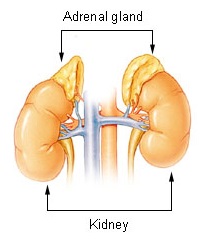|
Pregnanetriolone
Pregnanetriolone, or 11-ketopregnanetriol, is a steroid hormone A hormone (from the Greek participle , "setting in motion") is a class of signaling molecules in multicellular organisms that are sent to distant organs by complex biological processes to regulate physiology and behavior. Hormones are required .... Clinical significance There is no or little excretion of pregnanetriolone in the urine in healthy people. In patients with congenital adrenal hyperplasia due to 21-hydroxylase deficiency, the daily excretion exceeds 100 μg. ACTH stimulation test, ACTH stimulation increased excrement even further. It has been concluded since at least 1974 that the excretion of pregnenolone in urine after ACTH stimulation test can help detect heterozygous carriers of congenital adrenal hyperplasia caused by 21-hydroxylase deficiency. These conclusions were confirmed by later studies. See also * Pregnanetriol References 5β-Pregnanes Human metabolites {{Biochemistry-stub ... [...More Info...] [...Related Items...] OR: [Wikipedia] [Google] [Baidu] |
Pregnanetriol
Pregnanetriol, or 5β-pregnane-3α,17α,20α-triol, is a steroid and inactive metabolite of progesterone. Urine testing Urine excretion of pregnanetriol can be measured over a period of 24 hours. Elevated urine pregnanetriol levels suggest adrenogenital syndrome. In monitoring treatment with cortisol replacement, elevated urine pregnanetriol levels indicate insufficient dosage of cortisol.online-family-doctor.com Pregnanetriol Retrieved April 2011 Reference ranges For females: * 0 to 5 years: less than, < 0.1 mg/24 hours * 6 to 9 years: < 0.3 mg/24 hours * 10 to 15 years: 0.1 to 0.6 mg/24 hours * 16 years and older: 0 to 1.4 mg/ 24 hours. For males: * 0 to 5 years: < 0. ...[...More Info...] [...Related Items...] OR: [Wikipedia] [Google] [Baidu] |
Steroid
A steroid is a biologically active organic compound with four rings arranged in a specific molecular configuration. Steroids have two principal biological functions: as important components of cell membranes that alter membrane fluidity; and as signaling molecules. Hundreds of steroids are found in plants, animals and fungi. All steroids are manufactured in cells from the sterols lanosterol ( opisthokonts) or cycloartenol (plants). Lanosterol and cycloartenol are derived from the cyclization of the triterpene squalene. The steroid core structure is typically composed of seventeen carbon atoms, bonded in four " fused" rings: three six-member cyclohexane rings (rings A, B and C in the first illustration) and one five-member cyclopentane ring (the D ring). Steroids vary by the functional groups attached to this four-ring core and by the oxidation state of the rings. Sterols are forms of steroids with a hydroxy group at position three and a skeleton derived from cho ... [...More Info...] [...Related Items...] OR: [Wikipedia] [Google] [Baidu] |
Hormone
A hormone (from the Greek participle , "setting in motion") is a class of signaling molecules in multicellular organisms that are sent to distant organs by complex biological processes to regulate physiology and behavior. Hormones are required for the correct development of animals, plants and fungi. Due to the broad definition of a hormone (as a signaling molecule that exerts its effects far from its site of production), numerous kinds of molecules can be classified as hormones. Among the substances that can be considered hormones, are eicosanoids (e.g. prostaglandins and thromboxanes), steroids (e.g. oestrogen and brassinosteroid), amino acid derivatives (e.g. epinephrine and auxin), protein or peptides (e.g. insulin and CLE peptides), and gases (e.g. ethylene and nitric oxide). Hormones are used to communicate between organs and tissues. In vertebrates, hormones are responsible for regulating a variety of physiological processes and behavioral activities such as diges ... [...More Info...] [...Related Items...] OR: [Wikipedia] [Google] [Baidu] |
Congenital Adrenal Hyperplasia Due To 21-hydroxylase Deficiency
Congenital adrenal hyperplasia due to 21-hydroxylase deficiency, in all its forms, accounts for over 95% of diagnosed cases of congenital adrenal hyperplasia (CAH), and CAH in most contexts refers to 21-hydroxylase deficiency and different mutations related to enzyme impairment have been mapped on protein structure. Presentation Severe, early onset 21-hydroxylase deficient CAH The two most serious neonatal consequences of 21-hydroxylase deficiency occur: life-threatening salt-wasting crises in the first month of life (for male and female infants alike) and severe virilization of female infants. The subdivision of the early onset CAH into salt-wasting and simple-virilizing forms, which is based on the capacity of the adrenal to produce small amounts of aldosterone in the simple-virilizing form, is often not clinically meaningful, because clinical presentations overlap and all patients lose salt to some degree. Salt-wasting crises in infancy The excessive amounts of adrenal testo ... [...More Info...] [...Related Items...] OR: [Wikipedia] [Google] [Baidu] |
ACTH Stimulation Test
The ACTH test (also called the cosyntropin, tetracosactide, or Synacthen test) is a medical test usually requested and interpreted by endocrinologists to assess the functioning of the adrenal glands' stress response by measuring the adrenal response to adrenocorticotropic hormone (ACTH; corticotropin) or another corticotropic agent such as tetracosactide (cosyntropin, tetracosactrin; Synacthen) or alsactide (Synchrodyn). ACTH is a hormone produced in the anterior pituitary gland that stimulates the adrenal glands to release cortisol, dehydroepiandrosterone (DHEA), dehydroepiandrosterone sulfate (DHEA-S), and aldosterone. During the test, a small amount of synthetic ACTH is injected, and the amount of cortisol (and sometimes aldosterone) that the adrenals produce in response is measured. This test may cause mild side effects in some individuals. This test is used to diagnose or exclude primary and secondary adrenal insufficiency, Addison's disease, and related conditions. In addit ... [...More Info...] [...Related Items...] OR: [Wikipedia] [Google] [Baidu] |


